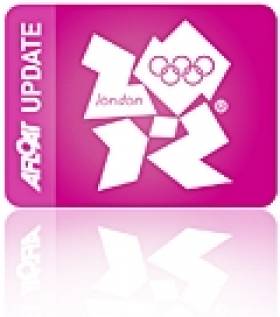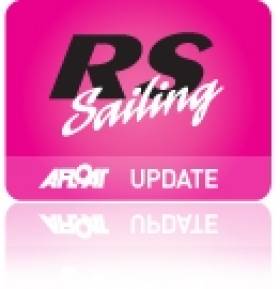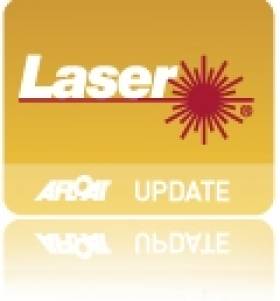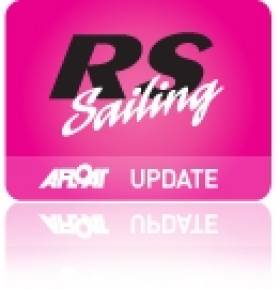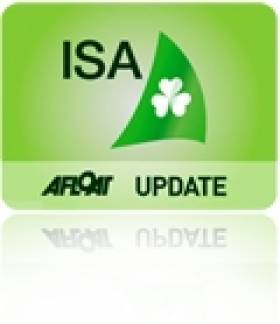Displaying items by tag: sailing
Podium Vision for Irish Olympic Sailing Team
#OLYMPIC SAILING – Ireland is on course for an Olympic sailing medal in London according to yesterday's Irish Sailing Association Olympic briefing. The sailing team will be 'on the podium' this summer according to the 'vision' unveiled by team manager James O'Callaghan. All three qualified crew for the Weymouth regatta in 100 days time were at the event held in Jury's hotel, Dublin. O'Callaghan says that the there are nine events left before the Olympics and to be on target for a medal the team, Annalise Murphy, Peter O'Leary and David Burrows and Ryan Seaton and Matt McGovern will need to take six medal race finishes and two medals from these warm up events to stay on target. The ISA also expect at least one more boat to qualify for the Games (from a possible three still campaigning) at next month's final qualification events. Irish Times Sailing Columnist David O'Brien has more on the story this morning here.
Lynch Leads Irish Laser Hopes at Youth Nationals
#ISAYOUTHNATS – Although there is a Portuguese leader of the Irish Laser Radial class championships, Dun Laoghaire's Finn Lynch is only three points adrift of Pedro Roque after the first two races in light airs of the Mitsubishi Irish Youth National Championships off Dun Laoghaire today.
The event, attended by ten countries, is a test event for July's ISAF Four Star Pizza Youth World Championships to be staged in Dun Laoghaire. Seven classes of boat and 380 youth sailors are competing in a combined fleet of nearly 300 boats.
Strangford Lough's Robbie Gilmore is one behind Lynch in third on nine points and Kinsale's Colm O'Regan is fifth in the 67-boat fleet.
Hotly tipped for the Irish team at the youth worlds in the Laser radial class Sophie Murphy finished the day 12th and first girl five places clear of selection rival Sian Kneafsey of the National Yacht Club.
French female teams top the 420 leader board in first and second places but Ireland's Robert Dickson and Sean Waddilove from Howth are third after two races in the 26-boat fleet.
So far there are no results available this evening for the Toppers, Laser 4.7s and Fevas or Optimist fleets.
Day one results
Laser Radial
1st - Pedro Roque (Clube Naval de Portimo; POR) 2nd - Finn Lynch (National YC; IRL) 3rd- Robbie Gilmore (Strangford Lough YC; GBR)
420s
1st – Jennifer Poret/Louise Chevet (SNPH; FRA) 2nd - Guillaume Pirouellel/Valentine Sipan (SNPH; FRA) 3rd - Robert Dickson/Sean Waddilove (HYC; IRL)
29ers
1st - Jack Hawkins/ Christopher Thomas (Restronguet SC; GBR) 2nd – Owen Bowerman/ Morgan Peach (Hayling Yacht Club; GBR) 3rd – Trent Rippey/ Alex Munroe (Tauranga YC; NZL)
Results here.
Additional reporting from organisers:
(Thursday 12th April 2011 @ 1900 hrs) Light and changeable winds got the tenth, four-day ISA Mitsubishi National Youth Championship 2012 off to a mixed start on Dublin Bay today with a fleet of 100 boats across three classes (Laser Radial, 420 and 29s). 283 boats across the full seven classes competing, will be out in the Bay from tomorrow representing the very best in Irish youth sailing. The 'Nationals' is primarily a Test Event for the Four Star Pizza ISAF Youth Sailing World Championship scheduled to take place also in Dublin Bay in July 2012 and the Irish team for the Championship will be announced on the closing day of the Nationals (Sunday 15th April.)
The Laser Radial, the chosen class used for the single handed boys and girls, follows a one-design concept where all boats are identical and where sailors skills are scrutinised above all else. In the boys, amongst those vying for a place on the Irish team at the Four Star Pizza ISAF Youth Worlds are ISA Academy members Robbie Gilmore, Finn Lynch and Seafra Guilfoyle and in the girls, Sophie Murphy and Sian Kneafsey are fighting for the single spot. Today Finn Lynch from the National Yacht Club in Dun Laoghaire took second place and Robbie Gilmore from Strangford Yacht Club, Down, took third.
The 420s is the double handed boat for all the boys and girls teams and teamwork and communications are of prime importance in this class. Robert Dickson and Sean Waddilove will fight it out against Patrick Crosbie and Grattan Roberts for the Four Star Pizza ISAF Youth Worlds place, which history tells us has been an indicator of future Olympic success. Today Robert Dickson and Sean Waddilove from Howth YC took third place in this highly competitive class.
The 29er is a lightweight high performance skiff designed for two people which provides the stepping stone for the high octane 49er Olympic class and where the crew can be mixed. At this year's Youth Nationals we have representation from Great Britain and New Zealand in the small fleet where quality is high. Amongst the three 29er's competing today, Jack Hawkins and Christopher Thomas representing GBR from Restronguet SC in Falmouth took line honours with Owen Bowerman and Morgan Peach from Hayling Island SC coming in second.
Deadine Looms for ICRA Entry Discount
#ICRA – Over 50 boats have aready entered the ICRA Nationals in Howth and another 50 are expected but the offer of a reduced entry feef from €175 to €125 for the BMW sponsored event expires this weekend.The offer includes marina berthage and three days of racing to decide the 2012 Cruiser National Champions in all Classes in both IRC and Echo handicap systems.
Running alongside the Nationals will be a non spinnaker event capturing the spirit of this style of sailing the Corinthian Cup with 2 magnificent trophies on offer.
RS Classes Head Inland to Lough Ree
The Irish RS Dinghy Class Association Inland Championship is set to take place at Lough Ree Yacht Club on the weekend of the 28th and 29th of April.
This will be the first time the Feva class will join up the RS200's and RS400's for a regional event. It will also be the inaugural RS Inland Championship. The Notice of Race is available to download below.
No doubt the ever popular Feva's will be sharp following on from The ISA Mitsubishi Youth Nationals this weekend.
The RS200's and 400's classes have seen very strong growth over the past season and are sure to be hotly contested.
The RS200 which is seen as the natural progression from the Feva has seen the class starting to emerge in new areas along with the traditional stronghold of Greystones. Dun Laoghaire is now home to five 200's. Newcastle YC in Co. Down now boasts a fleet of five 200's and Howth YC recently saw the arrival the first 200 to the club.
The RS400 has seen similar growth with five Dun Laoghaire based 400's, the continually growing fleet in Greystones and a very strong showing in the North were no less than fourteen RS400's contested the Ballyhome Icebreaker series.
With such a strong calendar it all bodes well for the upcoming season and the continued growth of all three classes.
|
2012 RS Events 28-29 April 2012 |
Inlands |
Feva,200/400 |
Lough Ree YC |
|
30 June & 1 July 2012 |
Easterns |
Feva,200/400 |
Newcastle |
|
23-27 July 2012 |
Eurocup |
RS classes |
Lake Garda, Italy |
|
17-19 Aug 2012 |
Nationals |
Feva,200/400 |
Howth YC |
|
19-23 Aug 2012 |
UK Nationals |
RS 200 |
Exe SC |
|
8-12 Sept 2012 |
UK Nationals |
RS 400 |
Royal Torbay YC |
|
15-16 Sept 2012 |
Northerns |
Feva,200/400 |
Strangford Lough |
|
6-7 Oct 2012 |
Southerns |
Feva,200/400 |
Greystones |
|
20 Oct 2012 |
Sprint |
RS 200/400 |
RStGYC |
UK Laser Sailors in £50K Irish Sea Crossing Challenge
#LASER - A pair of British sailors are set to embark on an intrepid crossing of the Irish Sea using just two single-handed Laser dingies.
David Summerville and Steve Cockerill had originally planned to make the crossing in September last year, but those plans were scuppered by 50-knot gale force winds and a 12-foot tidal swell, according to Incentive Travel.
But the duo is now planning to try again, with the backing of the Ramada Plaza Southport.
“David and Steve will be covering 115 nautical miles during the challenge," said Ramada Plaza general manager Enda Rylands. "They will set off from my own home town of Dublin and finish in Southport, aiming to raise £50,000 for mental health charity Mind and the John Merricks Sailing Trust."
Summerville, a 53-year-old grandfather of two who runs a boat repair business, said the date of the challenge would again depend on weather and tidal conditions, and that the pair is ready to depart any time from mid-April to mid-September.
It's not the first time that an Irish Sea crossing has been done in a Laser as Tiffany Brien achieved the feat in 2010, sailing single-handedly the 30 miles from Portpatrick in Scotland to Belfast Lough.
But Summerville and Cockerill's ambitious undertaking, at more than three times that distance, would surely get them a place in the record books - provided the weather goes their way!
RS200/400 Demo at Royal St George Next Weekend
#RS SAILING - UK RS Association chairman Pete Vincent will be running another RS200 and 400 demo day from the Royal St George Yacht Club on the weekend of 24-25 March.
The well-known expert on RS boats is being brought to Dublin by RS400 owners Richard Tate and Emmet Ryan, who are "really keen to get an RS fleet up and running" in Dun Laoghaire.
"After the huge attention our boats have drawn both ashore and on the water, we feel there is already a keen interest from a broad cross section of sailors to learn something more about these incredible hiking dinghies," says Tate.
"There is a ready-to-race format for both RS200s and 400s to have a full season of racing every Tuesday and Thursday in Dublin Bay right from the go."
The RS200 is described as a "natural progression" from the RS Feva, while the RS400 "takes the concept one step further and way beyond". Both classes provide high performance assymmetrical racing for all age groups.
If you are thinking about moving into an RS200 or 400, this is the perfect opportunity to help you make your decision.
All demo sails must be booked in advance by contacting Pete Vincent directly at +44 7812 899 043 or [email protected].
Learning How to Sail is Easy, Once you Get Started!
#HOW TO SAIL – Just how many beginners who want to find out how to sail start out thumbing through the yachts for sale columns? If you're new to the sport of yachting it can be difficult to get started so there's a need to be smart about your approach. The good news is that to learn how to sail a boat you don't need to own one.
Because there are so many potential pitfalls in buying a boat (not least the fact you may for one reason or another end up not liking it) the most prudent idea is to keep your money in your pocket and plunge instead for a short learn to sail course at a yacht club or sailing school first.
This is a great way to put your toe in the water if you'll excuse the pun. It's a means of meeting like minded people, asking relevant questions, finding out more about sailing boats and classes but most of all it is a means of getting valuable tiller time on the basics of sailing. It involves no financial outlay other than the cost of a sailing course (see below) but offers a window to a sport that you (and your whole family) can enjoy together for the rest of your lives.
Many of the bewildering aspects of how to sail can be short-circuited within the safe environment of a sailing school or a sailing club. Experienced sailing instructors leave you free to enjoy the experience of getting afloat for the first time rather than dealing with the potential headaches of boat ownership on your own.
Ultimately then armed with a sailing certificate or at least some hands on knowledge you can look around at what's available to suit you, your family and your pocket in the boats for sale market.
Is it small boat sailing in Dun Laoghaire and Dublin Bay? Cruiser Racing in Cork harbour or just relaxing on a swinging on a mooring in the sunshine of Galway Bay? The great thing about sailing is the choice is so wide it caters for all.
Sail training and learning to sail courses come in many different formats from dinghy sailing to tall ship sailing. Courses have different types of accreditation. Some are devised by the Irish Sailing Association (ISA) and others from the Royal Yachting Association (RYA). Many of the estimated 100 centres and clubs offer certification from both.

Once you've mastered the basics you can explore new horizons
Sailing is not a pastime where you will learn the lot all in one go, so there's no need for cramming. Instead it's wise to start with a basic course and add new skills as you wish. As many Olympic helmsmen will tell you 'nobody knows it all in sailing'.
For many, learning the ropes can often lead to a rewarding career in sailing. Starting off as a competent crew can move on to sailing instructor qualifications and maybe a professional ticket that can be used working abroad in sailing holiday charter companies such as flotilla holiday crew or boat charter.
Learn to sail courses are operated around the coast by a network of sailing schools and clubs and for the 2012 season Bernadette Fox looked at what was on offer and picked out a selection of learn to sail in Ireland options from right around the coast.
HOW TO SAIL, WHERE TO SAIL
As the year unfolds and you start to think of new beginnings, why not let yourself be tempted to try sailing. Young or young at heart, extremely fit or just average, there is an option out there for you to try out some form of this sport.
Sailing boats range from colourful small craft to the larger yacht complete with galley and heads, that’s kitchen and toilet to landlubbers. In either case, the skills involved are very much the same. Learn to drive in a Mini and you should know how to drive a Porsche, or vice versa.
There are certified training courses available in training centres accredited by the ISA or the RYA. Certified courses progress you along a proven path from raw beginner to expert racing or cruising sailor. However, many training centres also offer courses that are more introductory in nature, designed to tempt you into this exciting world.
The Irish National Sailing School and Club with a fleet of 18 boats in Dun Laoghaire, Co Dublin offers a range of introductory options. Their three hour Taster Session for €69.00 is ideal for those going afloat for the first time. Stepping on board, the Instructor/Skipper will introduce you to your fellow sailors and by the time you are sailing out of the Harbour, you are part of the crew. For a group of friends or work colleagues, there are bespoke Group Offerings and believe me, an evening afloat on Dublin Bay after a hectic day in the office can be just bliss.
By contrast Heir Island Sailing School limits its numbers to just 21 sailors at a time. Heir Island is one of Carbery’s 110 Isles in Roaringwater Bay, off Skibbereen, West Cork and provides great sailing waters. A Bord Failte approved residential centre, Heir Island is popular with both families and groups of friends, many of whom return more than once. Be warned though, they book out quickly.
Almost next door is the Fastnet Marine and Outdoor Education Centre in Schull, Co Cork. Schull is a great holiday destination for families and despite its name, Roaringwater Bay provides sheltered waters for the novice sailor. Sign up for a full or half day on their 26-foot keelboat and receive a basic introduction to sailing. The day trips are suitable for groups or families and if the youngsters get hooked, there are week long sailing courses throughout the summer.
To splash about further west, the Dingle Sailing Centre in Kerry invites you to build your confidence on the water. If you are interested in getting afloat, there are both summer camps for children and opportunities for those more mature. Adult training courses are subject to demand but are tailored to suit your needs.
Meanwhile, if you are in Cork city, SailCork.com offers plenty of sailing in Cobh, Cork Harbour using their “tried and tested system” to introduce you to sailing. Their Taste of Sailing session costs €58 per person, €150 family or €99 for couples and according to their website, with their experienced instructors, provides a “blast”.
Close to Kinsale, Co Cork is The Oysterhaven Centre where you can sign up for their May Madness Taster Day; book any Saturday in May for e95 and you can bring a friend for free. Once you get hooked, you might even return, to stay in one of their holiday cottages overlooking Oysterhaven Bay, and really embrace Sailing.
Right in the heart of Kinsale is Sovereign Sailing operating out of the Trident Marina. If you are curious about sailing, for e45 euro per person, you can go yachting for a half day. Depending on conditions, like wind direction and strength, you sail to either the Old Head of Kinsale or around the Sovereign rocks. Along the way, under the skipper’s supervision, you can trim the sails and steer the boat; of course you could always just sit back and enjoy your surroundings.
While Kinsale is renowned for gourmet food, at Carlingford Sailing School your Skipper is not just an experienced Yachtmaster but also an award-winning chef. With a weekend introduction to sailing at just e395, this live-and-dine onboard experience is suitable for beginners. The pupil-to-teacher ratio of 5 to 1 is not exceeded so you will receive plenty of personal instruction. At night, the seven berth 36 foot yacht returns to the marina where the village of Carlingford beckons to those on a high following their time afloat.
Based in the nearby sailing club is the Carlingford Sail Training Centre who introduces all ages and abilities to the water. Their boats range from the responsive dinghy to the larger yacht. For €75 you sail along Carlingford Lough aboard one of their yachts on their Taste of Sailing Course. As they are also based in the Club if you are bitten by the bug you will soon meet other like-minded folk.
Closest to the village is the Carlingford Adventure Centre which includes sailing among their activities. As they can also provide comfortable accommodation the Centre is ideal for groups including hen or stag parties. No taxis required!
Lake sailing is another option, with the advantage of no salt or tides to consider. The University of Limerick Activity Centre is just outside Killaloe on Lough Derg. One day course for e100 provides a great introduction to the thrill of sailing. They will also tailor packages for groups, including hen and stag parties, which can also include other activities.
With Galway’s Bow Waves (www.bowwaves.com) you can choose to sail in either a dinghy or yacht. Dinghy sailing on Lough Atalia is great fun but it does require reasonable fitness and flexibility to pull yourself back into the boat after a capsize. For e65, all equipment, including wetsuits and life jackets are provided for the half-day session.
Visiting the sunny south east, Kilmore Quay, Co Wexford is perfect for a short break destination and the base of Sailing Ireland. A half day’s sail to the Saltee Islands, with its bird sanctuary and seal colony, is €50 per adult and includes a basic sailing lesson and the chance to helm the boat under instruction.
Professional but friendly is the tag line of Aquatrek Sea Skills, Youghal, Co Cork. If you have no prior experience, Aquatrek aims to make your sailing experience a challenging but never a dangerous one. Once you have mastered the basics you can continue to get on the water each Saturday for as little as €10, depending on the weather of course.
Try sailing – you might just get hooked, at the very least you can cross another activity off your “to do” list.
Annalise Recognised for Olympic Sailing Achievement
#SAILING – Olympic Single handed sailor Annalise Murphy was recognised at home on Saturday night when the 22–year–old National Yacht Club sailor who won an Afloat Sailor of the Month award last May, lifted the Irish Sailing Association's (ISA) 'Achievement' Award for 2011.
She beat three other nominees including Afloat's Sailor of the Year winner George Kenefick, the Dragon Edinburgh Cup winner Martin Byrne and Windsurfer Noelle Doran who had all picked up Sailor of the Month Awards for their respective international achievements in 2011.
The weekend award ceremony was held on Saturday in the Royal Marine Hotel, Dun Laoghaire, Co. Dublin and presented by Minister for Sport, Leo Varadkar TD.
Annalise's tremendous successes in 2011 included fourth at the Miami World Cup in January followed by a podium finish at Sail for Gold in Weymouth where she took home the bronze medal. She then travelled to Perth in December for the ISAF World Championships where she finished sixth overall and qualified Ireland for the 2012 Olympics.
The weekend award for the top Young Sailor was won by Tralee's Sophie Browne who picked up Afloat's first sailor of the month award in January when she finished13th overall from 210 boats and picked up a Silver medal for second Girl. It was this result, say the association, that ultimately put her ahead of her fellow nominees, Patrick Crosbie, Peter McCann, Philip Doran and Seafra Guilfoyle.
The other winners included Michael McCarney from Co. Tipperary who won the ISA Volunteer of the Year award, Rachel Hoolahan from Greystones who won the ISA Instructor of the Year award and Rusheen Bay Windsurfing from Co. Galway took home the prize for Training Centre of the Year.
Full 2011 Afloat.ie/Irish Independent Sailor of the Month Award Citations here
Dublin Hosts First ISAF Development Symposium in March
#DEVELOPMENT - Representatives from the International Sailing Federation's member nations throughout the world will meet at Howth Yacht Club from 17-18 March for the inaugural ISAF Development Symposium.
The aim of the two-day conference is to develop the criteria and future strategy for sail training and development within the governing body of world sailing, based on three core requirements:
- Fulfilling requirement set out in the ISAF Constitution to develop the sport and increase participation;
- Providing a structure for the sport to grow to meet expectations of the International Olympic Committee; and
- Supporting member nations in growing the sport in their own countries.
"Training is the key that will unlock and secure the future for our sport," said the ISAF in its development statement at the federation's annual conference last year.
Dublin was chosen as the host location for this first symposium as it will be hosting the ISAF Youth Worlds in July, just before the 2012 Olympic Games in London.
The international delegates, chaired by event organiser and ISAF training and development manager Dan Jaspers, will be supported by a group of ISAF representatives such as vice president Nazli Imre, development and youth committee chairman Olivier Bovyn, ISAF-nominated experts and the World Youth Sailing Trust coach, as well as invited specialist technical advisors.
More information about the ISAF Development Symposium is available HERE.
How Can Clubs Cash in on Sailing's Spectator Appeal?
#SAILING – Can sailing be a spectator sport for a live audience or for direct transmission on television? Magheramore says it is already happening but the challenge is for clubs and classes to find a way to capitalise on the enthusiasm already generated on professional sailing circuits.
Two recent announcements have made this question of particular interest at the moment: the announcement of the course for the next America's Cup and the RYA Tribunal report effectively closing the "Ainslie" affair.
The 34th America's Cup will effectively take place in a nautical stadium along the San Fransico waterfront, with spectators being able to follow the whole race from the shore.
This is good news for owners of any property with a view over the bay. Purists, amateurs of the classic windward-leeward form of match racing may be less pleased.

The new San Franciso 'stadium' for the 2013 America's Cup
Two issues did not come to the fore in the heated discussions concerning Ben Ainslie's "frank discussion" with a camera boat driver. Firstly, the race course was placed close to the shore for the benefit of spectators, in an area where sea patterns were already disturbed as waves reflected off the breakwaters.
Secondly, this was no rogue cameraman and driver. They were media contracted by ISAF to provide television images at events organised by our sport's governing body.
The truth is that sailing is already a spectator sport. Many participants, including Ben Ainslie, and their support teams, earn a living as a result. Their lifestyle (which may not always be opulent) is funded by revenue generated by the sale of images which provide the basis of most sponsorship deals. If nobody gets to see the racing (either directly or though reports, resumes or pictures) then that revenue will disappear. ISAF has been told clearly that either sailing gets screen time or it will be out of the Olympics. Without the revenue generated by the Olympics many national sailing federations will be in financial trouble.

Schull in West Cork turns out for the 2011 ISAF Team Racing World Championships. Photo: Brian Carlin
Some sailing events are naturally spectacular and spectator friendly. Any of you who have witnessed the knock-out rounds of the Wilson Trophy, Europs's premier team racing event, will know what I mean. The course is no bigger than a football pitch, with boats sailing to within a few metres of the packed grandstand. Teams are clearly identified by coloured hulls and sails, with crew assigned to specific boats. In this way the team of commentators know who is in each boat. The running commentary keeps the somewhat partisan crowd fully informed. The atmosphere resembles the famous chariot race scene from Ben Hur. Nothing in Olympic sailing is as exciting and as perfect for television.
Other events are specifically organised to attract spectators and media. The French oceanic races are an example. The media build up can last a week or more, with radio and TV brodcasting live from the quayside. The sponsors of the event and the competing boats vie with each other to attract the attention of the thousands of visitors who come to see the boats, meet the sailors be entertained, and, this is France after all, fed. Sponsorship is facilitated by tax arrangements so that even quite small companies can get involved. The investment in a boat and crew is worthwhile as sailing, and especially the big races, are one of the most televised sports.
The start of a race will, of course, be timed so that the last few minutes before the gun can be shown live on the midday news. The media is omnipresent – helicopters buzz overhead, motor boats flood the start area, whilst the more audacious photographers zoom around on jet-skis, with the camera attached to their helmet. A disparate fleet of spectator boats line up along the edge of the no-go zone; car ferries, tourist boats (the 3 course lunch is included), old gaffers, cruisers, RIBs... anything goes. The scene resembles the evacuation from Dunkirk (without the guns!). In the midst of all this, professional sailors try to manoeuvre their boats to the start line without damage to their own boats or the fleet milling around them.
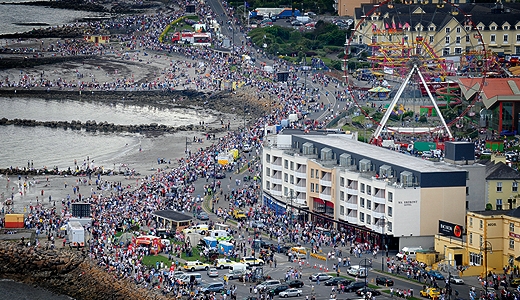
Crowds turnout for the 2009 VOR in Galway. Photo: Rick Tomlinson
We all remember the Volvo in Galway. The French do this several times a year, forming the basis of a whole industry, from boat-builders and sailmakers to event organisers, coaches, journalists.
Professional sailors will increasingly have to realise that they are in the entertainment business. Their job is not to win races but to win prime time minutes and column inches for their sponsors. Events for professional sailors will be designed to be spectacular and television friendly. Some of these events, such as the next America's Cup, will bear little ressemblance to the racing that we, the recreational sailors, enjoy.
The challenge, for federations, clubs, classes and all sailors is how to harness the enthusiasm generated by the professional circuits to benefit sailing as a whole. – Magheramore




























